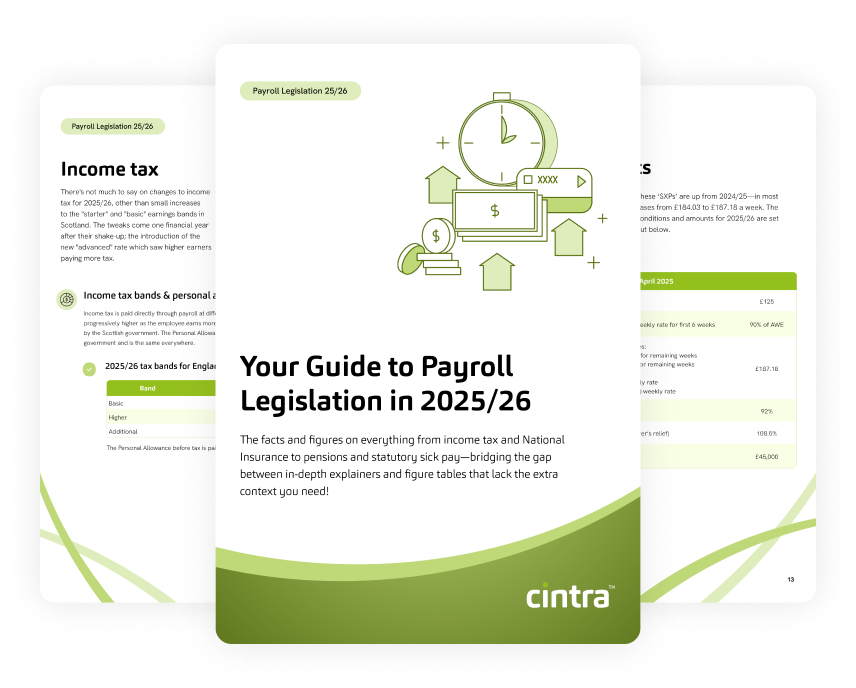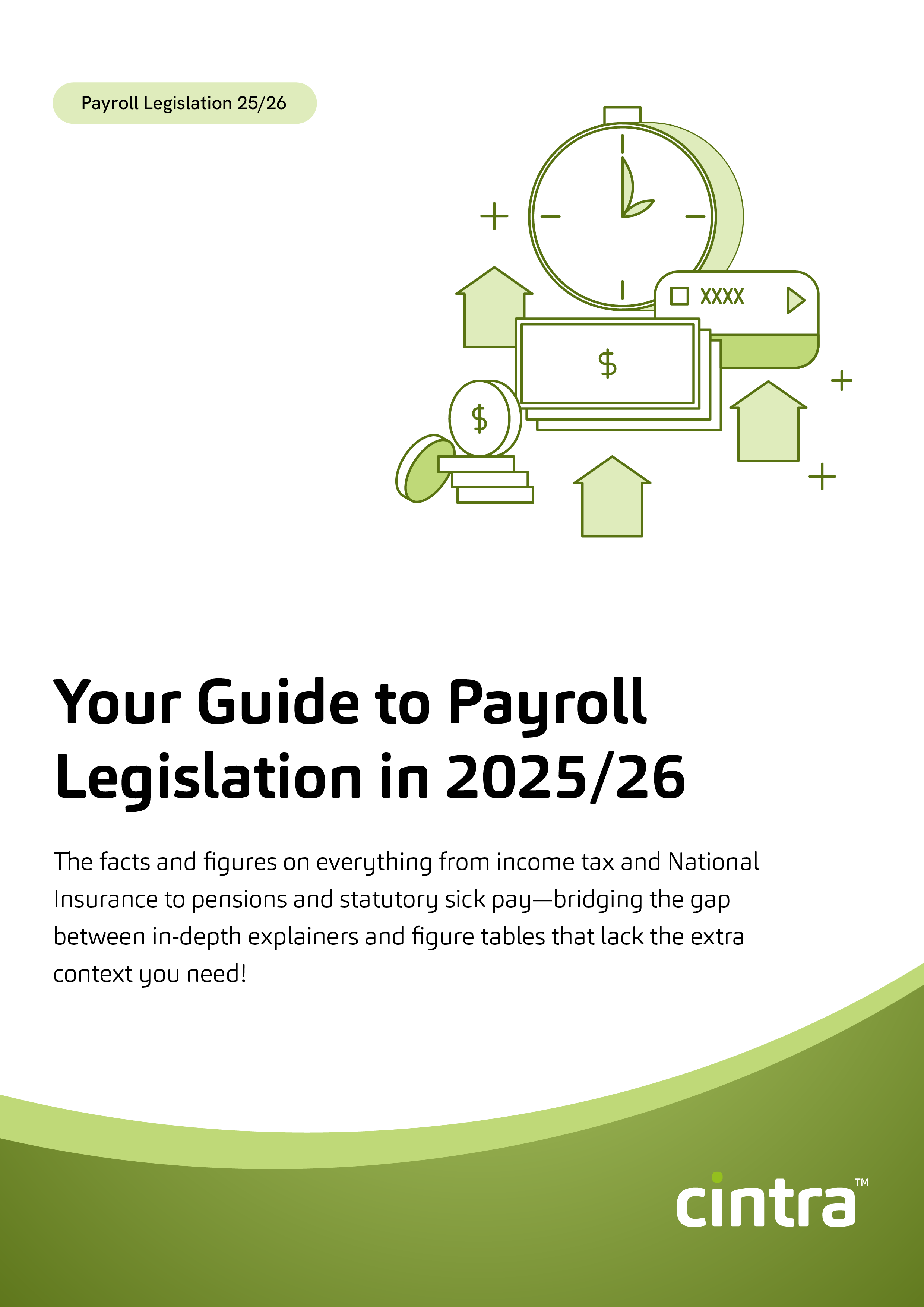From changes to tax rates and National Insurance to minimum wage and statutory payments, a new financial year always comes with new rates and figures set by HMRC for you to keep on top of.
And 2025/26 is no different, so we’ve dove into 5 key payroll changes coming into force in the new fiscal year. Here, you’ll find changes to tax rates in Scotland, employer National Insurance, national minimum wage, statutory leave payments, and student loans.
Income tax
While the income tax bands and rates are remaining the same in England, Wales, and Northern Ireland as the 2024/25 tax year, there are some minor tweaks coming to the “starter” and “basic” earnings bands in Scotland for 2025/26.
| Band | Rate | Earnings (after personal allowance) |
|---|---|---|
| Starter | 19% | Up to £2,827 (up from £2,306) |
| Basic | 20% | From £2,828 to £14,921(up from £2,307 to £13,991) |
| Intermediate | 21% | From £14,922 to £31,092 |
| Higher | 42% | From £31,093 to £62,430 |
| Advanced | 45% | From £62,431 to £125,140 |
| Top | 48% | Above £125,140 |
The changes mean all workers with earnings within those bands will be paying slightly less tax than previous years.
But it’s likely that their total tax bill won’t change significantly due to the tweaks being small, and the more someone earns over the affected bands, the smaller the impact of the tax cut on their overall liability!
Personal Allowance
Across the whole of the UK, the personal allowance remains frozen at £12,570, as it was in 2024/25. So, the entirety of the UK will be experiencing a ‘fiscal drag’ as wages rise with inflation, but the personal allowance remains the same.
For those not in the know: The House of Commons defines a fiscal drag as “Freezing tax thresholds increases people’s taxable income without nominal tax rates actually increasing. This results in additional revenue to the Government. This phenomenon is called ‘fiscal drag’, as more taxpayers are ‘dragged’ into paying more tax, or into paying at a higher rate.”
National Insurance contributions (NICs)
Employee NICs (primary contributions) are staying the same for 2025/26, with the majority of employees continuing to pay their 8% contribution. The biggest shake up, though, is to the secondary contributions, which will see businesses of all sizes hit with a bigger employer National Insurance bill than previous years.
From April 2025, employer’s NI rate increases to 15% from 13.8%. There’s also a decrease to the Secondary Threshold, from £9,100 to £5,000. That means that while employers are not only paying a higher percentage of NI on their employee’s earnings, but they’ll also start paying it on earnings starting at £417 per month instead of £758.
Here’s what the National Insurance changes will look like on an annual basis for employees earning £20,000, £40,000, and £60,000:
| Salary | Tax Year | Annual NI-able Earnings | Annual Employer NI | Annual Increase |
|---|---|---|---|---|
| £20,000 | 2024/25 | £10,904 | £1,504.75 | +£744.65 |
| 2025/26 | £14,996 | £2,249.4 | ||
| £40,000 | 2024/25 | £30,904 | £4,264.75 | +£984.65 |
| 2025/26 | £34,995 | £5,249.4 | ||
| £60,000 | 2024/25 | £50,904 | £7,024.75 | +£1,224.65 |
| 2025/26 | £54,996 | £8,249.4 | ||
It’s no surprise that the increases have caused concern amongst many businesses, with one survey revealing 58% of firms expect it to have a negative impact on their recruitment plans because of the rising costs of employment. Many are ultimately having to find a way to off-set the higher NI bill, with widely reported changes to things like product pricing, redundancies, and restructuring workforce models.
Get the latest insights and best practice guides, direct to your inbox.
National minimum wage
Also widely reported to sit with NICs on rising employment costs, national minimum wage is seeing another boost for 2025/26. The rates that apply from 1 April 2025 are as follows:
| NMW Rate | Increase (£) | Percentage increase | |
|---|---|---|---|
| National Living Wage (21 and over) | £12.21 | £0.77 | 6.7 |
| 18–20-year-old rate | £10.00 | £1.40 | 16.3 |
| 16–17-year-old rate | £7.55 | £1.15 | 18 |
| Apprentice Rate | £7.55 | £1.15 | 18 |
| Accommodation offset | £10.66 | £0.67 | 6.7 |
Statutory payments
‘SXPs’ are also seeing a small increase for 2025/26, covering all types of parental pay and sick pay.
A new parental pay rate of £187.18 (up from £184.03), from 6 April 2025, applies to:
- Statutory Maternity Pay (SMP)
- Statutory Adoption Pay (SAP)
- Statutory Paternity Pay (SPP)
- Statutory Shared Parental Pay (ShPP)
- Statutory Neonatal Care Pay (SNCP) – new as of April 2025
The statutory sick pay rate is also set to increase to £118.75 per week (up from £116.75) from 6 April 2024.
The minimum average weekly earnings (AWE) to qualify for ‘SXPs’ has also changed for 2025/26. This is now set at £125, up from £123.
Student loan repayments
2025/26 marks a change for those on plan 2 for the first time since the 2021/22 fiscal year—with the threshold now sitting at £28,470 instead of £27,295. That means they’ll join those on plan 1 and plan 4 seeing a little extra in their pockets each month from the start of the new fiscal year.
The postgraduate loan repayment threshold remains frozen at £21,000.
The student loan thresholds and repayment rates for each plan in 2025/26 are as follows, comparable to the 2024/25 rate:
| Plan | Annual earnings threshold 2025/26 | Annual earnings threshold 2024/25 | Repayment rate |
|---|---|---|---|
| Plan 1 | £26,065 | £24,990 | 9% |
| Plan 2 | £28,470 | £27,295 | 9% |
| Plan 4 | £32,745 | £31,395 | 9% |
| Postgraduate | £21,000 | £21,000 | 6% |
A few other updates
- Statutory redundancy: the maximum weekly rate in England, Scotland, and Wales has increased to £719.
- Employment Allowance: eligible employers are now entitled to £10,500, up from £5,000, to offset Employers National Insurance.
- Company cars and vans:
- Van fuel benefit increases to £769.
- Van benefit increases to £4,020.
- Car fuel multiplier increases to £28,200.
Let us help you with that!
If you want payroll software to do the heavy lifting for you, Cintra Pay comes with all the statutory rates and thresholds you need included as standard.
Or if you prefer to outsource payroll, our CIPP-qualified experts become a true extension of your team and deliver the hard work for you.
Whichever you prefer, you’ll be running even the most complex payrolls with speed, accuracy, and compliance. Get in touch to find out more.

Payroll Legislation Guide
The facts, figures, thresholds and allowances for 2025/26 spanning tax, National Insurance, pensions, statutory payments and more.
Download now


